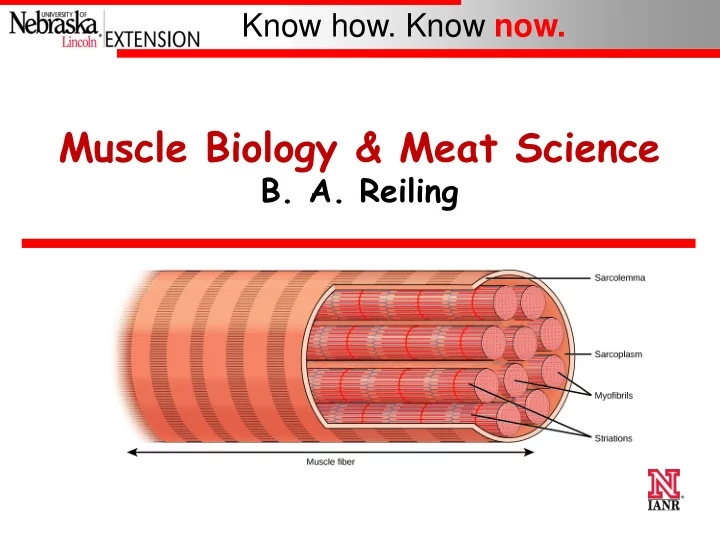

Know how. Know now. Muscle Biology & Meat Science B. A. Reiling
Know how. Know now. What is Meat? Animal tissue suitable for human consumption Fresh Meats no mechanical treatments or added ingredients • steaks, pork chops University of Nebraska – Lincoln
Know how. Know now. Conversion of Muscle into Meat Series of postmortem chemical reactions & physical changes Loss of blood loss of O 2 loss of ATP ATP = energy required for muscle movement With loss of ATP Rigor mortis Buildup of lactic acid pH from ~ 7.0 to 5.4 in 24 h University of Nebraska – Lincoln
Know how. Know now. With Anaerobic Metabolism, carbohydrates (glycogen) stored in muscle are broken Lactic ATP down for fuel, so muscle can Acid still contract post-mortem Lactic ATP CHO Acid for a limited time. CHO Lactic ATP Also creates Acid CHO “lactic acid” which causes the pH of muscle to drop from ~ 7.0 to 5.4 University of Nebraska – Lincoln
Know how. Know now. Conversion of Muscle into Meat Muscles are designed for 1 of 2 purposes 1) locomotion 2) support The anatomy, physiology, and function of each muscle affects meat palatability. Locomotive muscles more tough Support muscles more tender University of Nebraska – Lincoln
Know how. Know now. Palatability vs. Cost Preferred retail cuts ... Originate from the Rib & Loin (middle meats) • Muscles of support TENDER; < connective tissue Cost: $8 to $20 / lb Less expensive cuts ... Originate from the Chuck & Round (end meats) • Muscles of locomotion TOUGH; > connective tissue - Exception = Flat Iron Costs: $5 to $8 / lb University of Nebraska – Lincoln
Know how. Know now. Physical Composition of Meat Muscle major component Muscle fibers composed of proteins Connective tissue surrounds each muscle fiber and bundle Fat Bone University of Nebraska – Lincoln
Sarcomere Smallest contractual unit of the muscle
Know how. Know now. Slide adapted The Sarcomere from Ty Schmidt (UNL Meat Science) Comprised of overlapping protein filaments Thick filament = Myosin protein (80%) Thin filament – Actin protein (20%) University of Nebraska – Lincoln
Know how. Know now. Sarcomere in state of rest Slide adapted from Ty Schmidt (UNL Meat Science) (uncontracted) University of Nebraska – Lincoln
Know how. Know now. Slide adapted Sarcomere in contracted state from Ty Schmidt (UNL Meat Science) University of Nebraska – Lincoln
Know how. Know now. Slide adapted Myosin Protein – Thick filament from Ty Schmidt (UNL Meat Science) ATP University of Nebraska – Lincoln
Know how. Know now. Slide adapted Actin Protein – Thin filament from Ty Schmidt (UNL Meat Science) Myosin Binding Site University of Nebraska – Lincoln
Know how. Know now. Slide adapted Sarcomere – Uncontracted from Ty Schmidt (UNL Meat Science) ATP Myosin Binding Site University of Nebraska – Lincoln
Know how. Know now. Slide adapted Sarcomere – Contracted from Ty Schmidt (UNL Meat Science) Myosin Binding Site University of Nebraska – Lincoln
Know how. Know now. Flank Steak Tenderization Muscle fibers run in one direction If cut “with the grain” • Intact, long muscle fibers If cut “against the grain” • Many small pieces of fibers Mechanical tenderization Physical breakdown of muscle fiber cell walls University of Nebraska – Lincoln
Know how. Know now. Flank Steak Tenderization Chemical tenderization Meat is acidic (pH = 5.4) • Lactic acid production during rigor mortis Soy Sauce or Baking Soda is basic Chemical reaction breakdown of proteins Enzymatic Breakdown – Papain Breaks down the myosin protein University of Nebraska – Lincoln
Know how. Know now. Effect of Cooking on Tenderness For a TOUGH piece of meat, what cookery method should result in the most tender, cooked product? Why? Hey, this could be an experiment! University of Nebraska – Lincoln
Know how. Know now. Effect of Cooking on Tenderness Dry Heat -- Broiling & Grilling High temp, short time tender cuts Sear outside to “lock in” juice Fiber & connective tissue breakdown • not an issue; originated from muscles of support Moist Heat -- The “crock pot” Low temp, long time tough cuts • To an internal temp of ~180 o F Heat & moisture break down connective tissue University of Nebraska – Lincoln
Know how. Know now. Key Points: Muscle Biology Muscle requires energy (ATP) to contract During rigor mortis, muscle pH to 5.4 Muscle = bundles of muscle fibers Sarcomere is smallest contractile unit Muscles of support vs. locomotion University of Nebraska – Lincoln
Know how. Know now. Extension is a Division of the Institute of Agriculture and Natural Resources at the University of Nebraska – Lincoln cooperating with the Counties and the United States Department of Agriculture. The Youth Development program abides with the nondiscrimination policies of the University of Nebraska – Lincoln and the United States Department of Agriculture. University of Nebraska – Lincoln
Recommend
More recommend